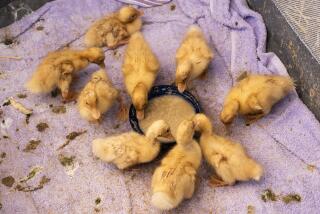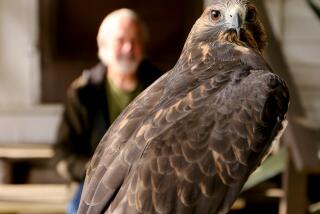Animal Program May Move : Wildlife: A Simi Valley rehabilitation and release effort might find a new home at the Point Mugu Navy base.
- Share via
Walk into Jerry Thompson’s Simi Valley back yard and you won’t find the prerequisite expanse of green lawn and shimmering blue pool.
*
Instead, you’ll find a cramped facility lined with cages and pens of all sizes holding a variety of sick and injured birds and animals.
In his nearby garage, you won’t find the family cars either. Instead, there is the animal version of a MASH unit.
“We are nearly out of room here,” said Thompson, who along with his wife, Kathy, co-founded the Raptor Rehabilitation and Release organization. “We’re already elbow-to-elbow.”
But soon, under a proposal jointly conceived by Thompson and Point Mugu Naval Air Weapons Station environmental officials, Thompson may be able to move to new digs roughly twice the size at the seaside base.
Under the plan, Thompson’s raptor program--named after the scientific moniker for flesh-eating birds of prey--would occupy an abandoned dolphin-training area on the base near Mugu Lagoon.
The nonprofit, all-volunteer organization also works with other animals besides birds of prey, such as shore and marine birds as well as reptiles, deer, raccoons, opossums, foxes and other animals indigenous to the county.
Presently, the program assists about 500 animals a year--more than 70% of which are returned to the wild.
“We are seeing this as a real opportunity to expand our services while at the same time expose more people to the wonders of these animals,” said Thompson, himself a longtime master falconer.
According to Tom Keeney, a Navy ecologist, the proposal gives the service a chance to expand its wildlife interpretation program while utilizing a facility that has been abandoned since the early 1960s when the Navy conducted dolphin research there.
At the site, situated near the northern mouth of Mugu Lagoon, five concrete marine mammal tanks of various sizes are now partially filled with dirt and other debris and in various states of disrepair.
Nearby, a small trailer that houses a variety of stuffed birds and animals serves as a makeshift Navy wildlife interpretation station--sharing space with computers and other gear recording data about the lagoon.
The proposal, which is still subject to final approval by base officials, calls for Thompson’s group to renovate the Point Mugu facility, build netted aviaries over the tanks and occupy an adjacent building.
Also, sick and injured birds and other animals that have been nursed back to health will be on display during public tours of the facility.
Keeney said that about 4,000 school-age children and adults take tours of the base’s wildlife interpretation program each year, and that the idea of combining the two efforts seemed a natural match.
“I think we’re very excited about this,” Keeney said. “Jerry is perfect for this kind of collaboration--he’s an expert in rehabilitation and extremely skilled in animal interpretation. His live animal presentations are excellent.”
Keeney said the Navy’s primary contribution to the effort will be in providing the land, and it may also provide the nonprofit group with some help in renovating electrical equipment and plumbing.
“The rest will be up to them, although we will help them whenever we can,” Keeney said. “By the interest shown already by our employees, I don’t think they’ll have trouble finding volunteers to run the place.”
The addition of the raptor group fits nicely into the Navy’s Natural Resources Management Plan, according to Ron Barrett, environmental protection specialist. Barrett said the management plan calls for the careful monitoring of all plants, animals and ecosystems that make up the lagoon and surrounding area--one of the last remaining salt marshes in the state.
“It’s going to be a tremendous help because there will be more eyes and ears out there,” Barrett said. “With downsizing, we can’t hire new people. Consequently, there are a lot of programs we can’t do because we don’t have the personnel. Jerry’s organization will go a long way toward helping us. His program really complements our efforts.”
For Thompson, who runs his program on a little less than $25,000 a year in contributions from the public, relocating to Point Mugu means that he will be able to show more people the wonders of animals they might not ever have a chance to see up close.
Working with scores of volunteer veterinarians and other wildlife specialists, Thompson’s program, which is licensed by the state Fish and Game Department and the U. S. Fish and Wildlife Service, helps nurse back to health eagles, hawks and a variety of other birds of prey.
Thompson said that process sometimes means reteaching the animals their hunting skills so they can survive again in the wild. He said it also sometimes means making more room in his facility for an animal that because of injury or illness will never again be able to fend for itself in the wild.
At the same time, a major focus for Thompson is educating the public on wildlife.
“The animal rehabilitation is just as important as the educating that we do,” said Thompson, who does hundreds of animal presentations each year. “What we teach first and foremost is respect for the animals. Without that, why go on?”
The arrival of the animal rehabilitation center on the base would ultimately be an intermediate step toward the eventual creation of an estimated $7-million native wildlife interpretive center to be situated off-base on California 1 near Mugu Rock.
But until then, Thompson and Navy officials said they hope to be able to start renovations this spring and open the new on-base facility by late summer.






